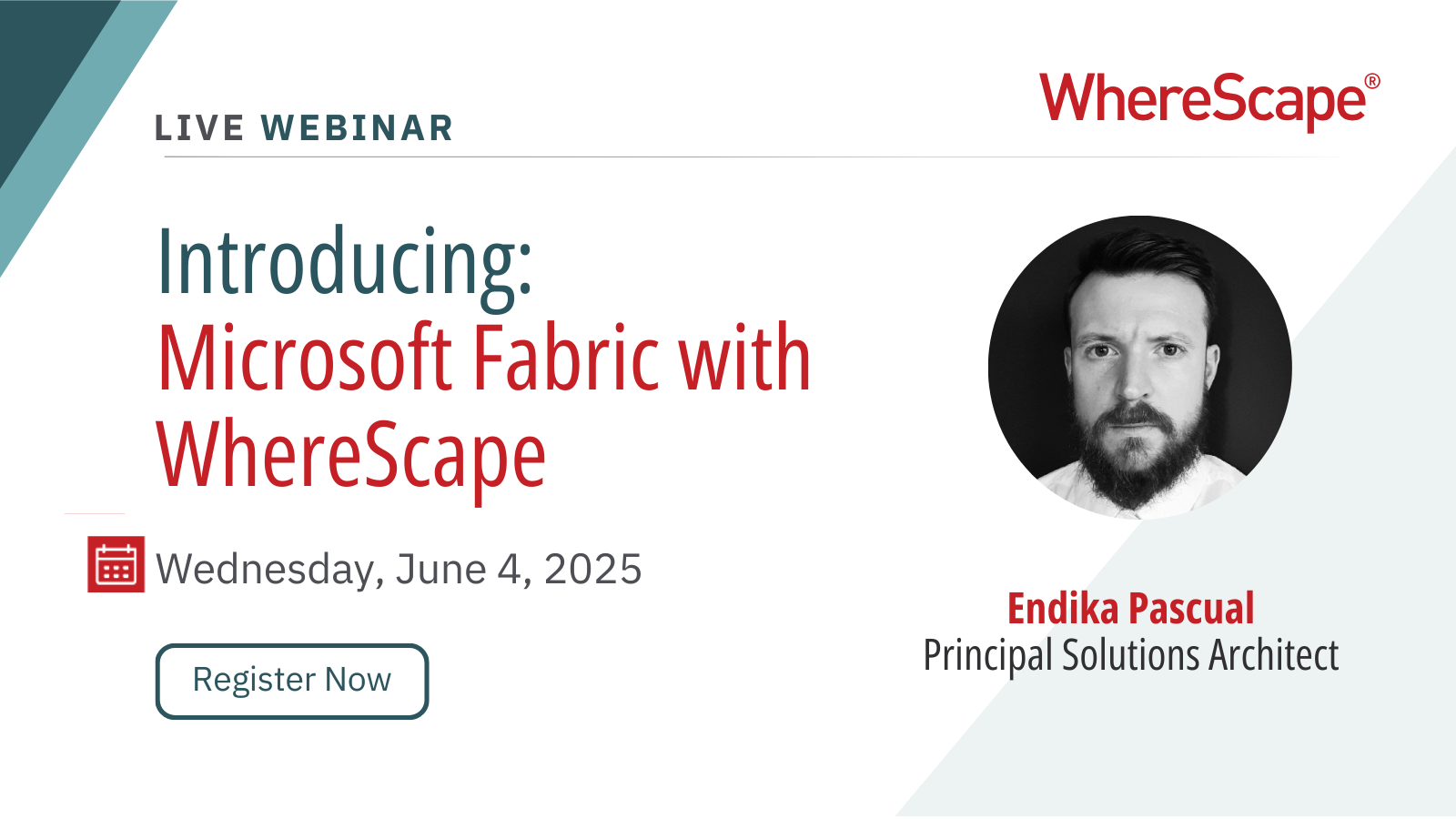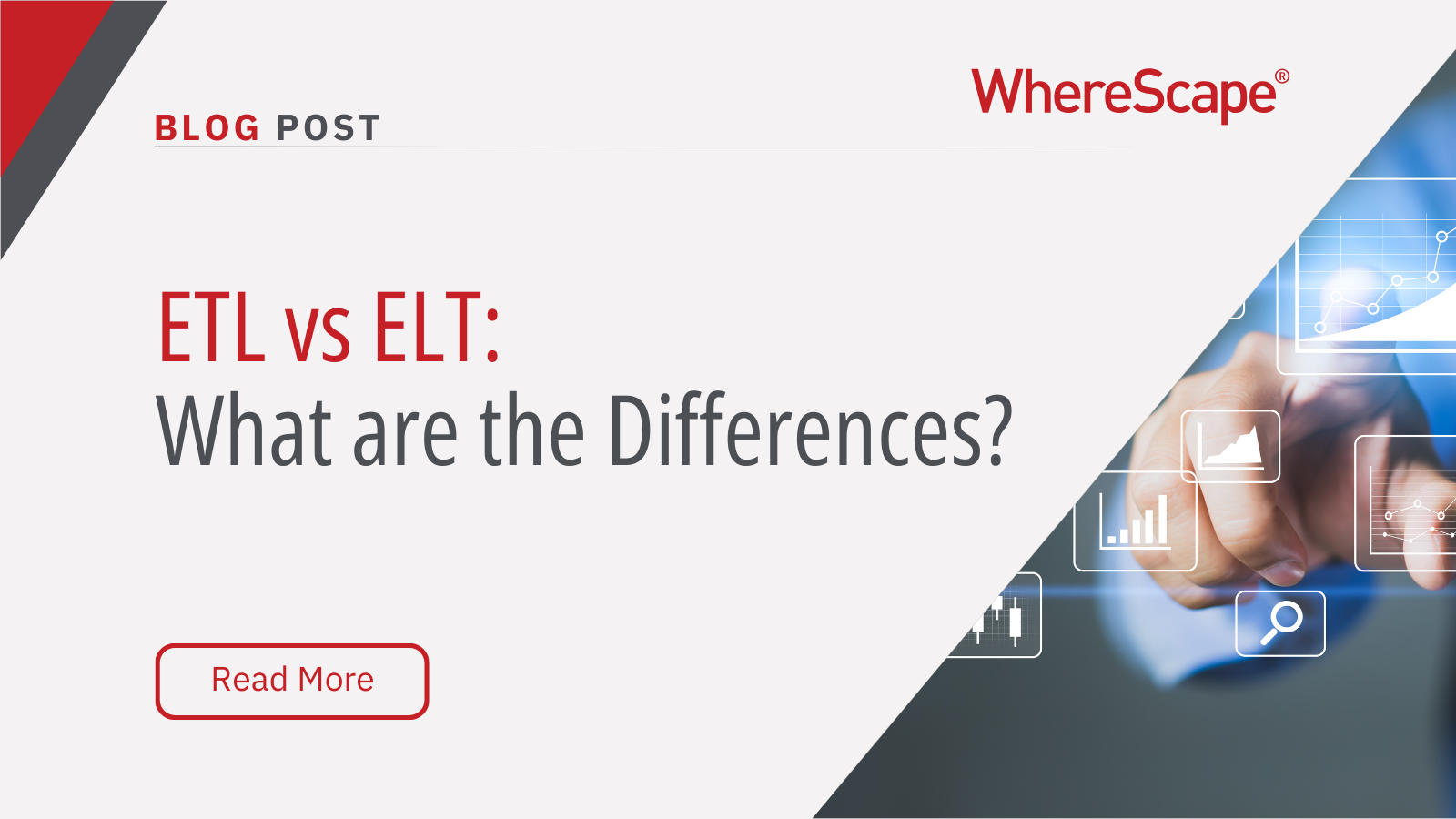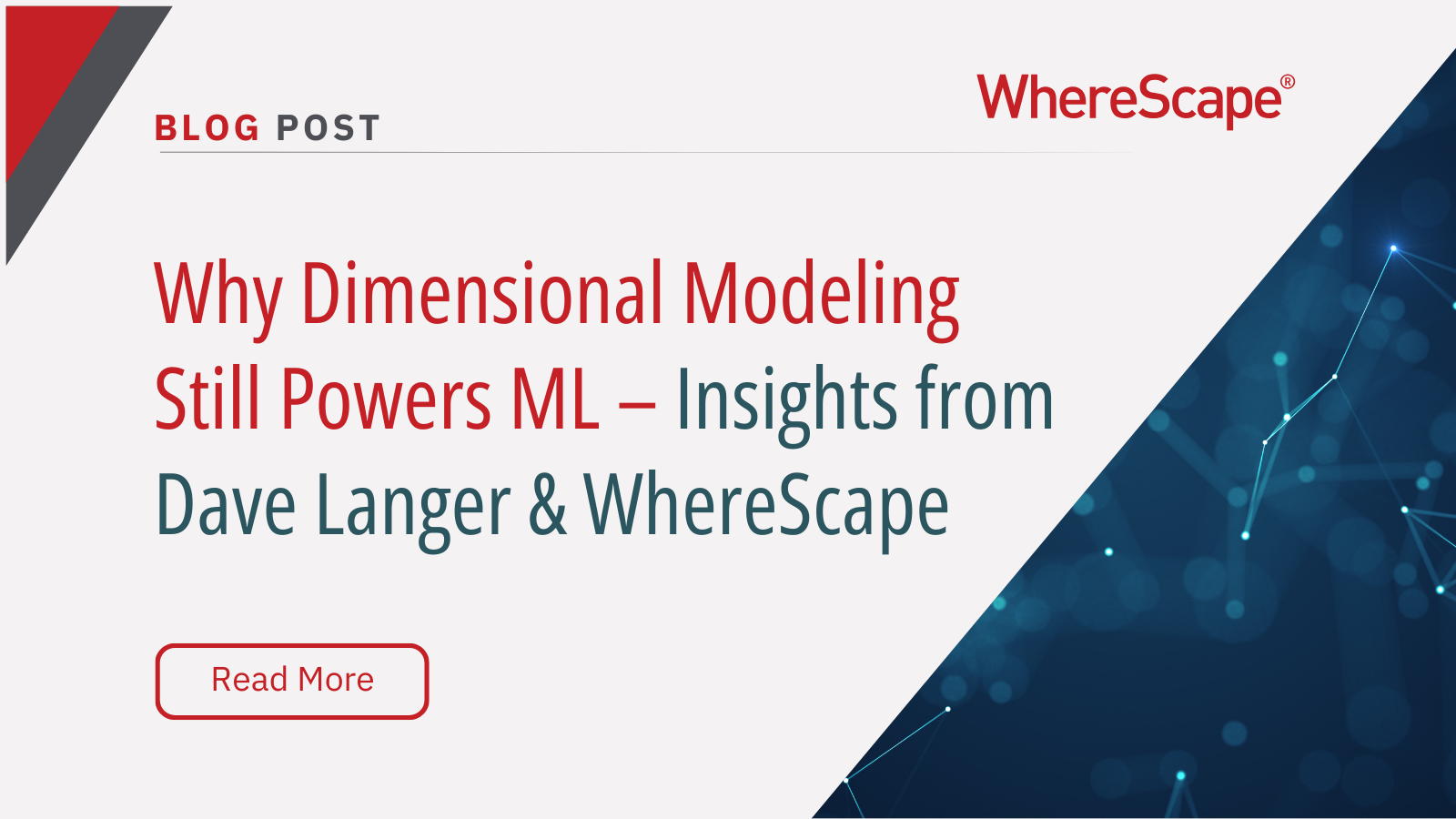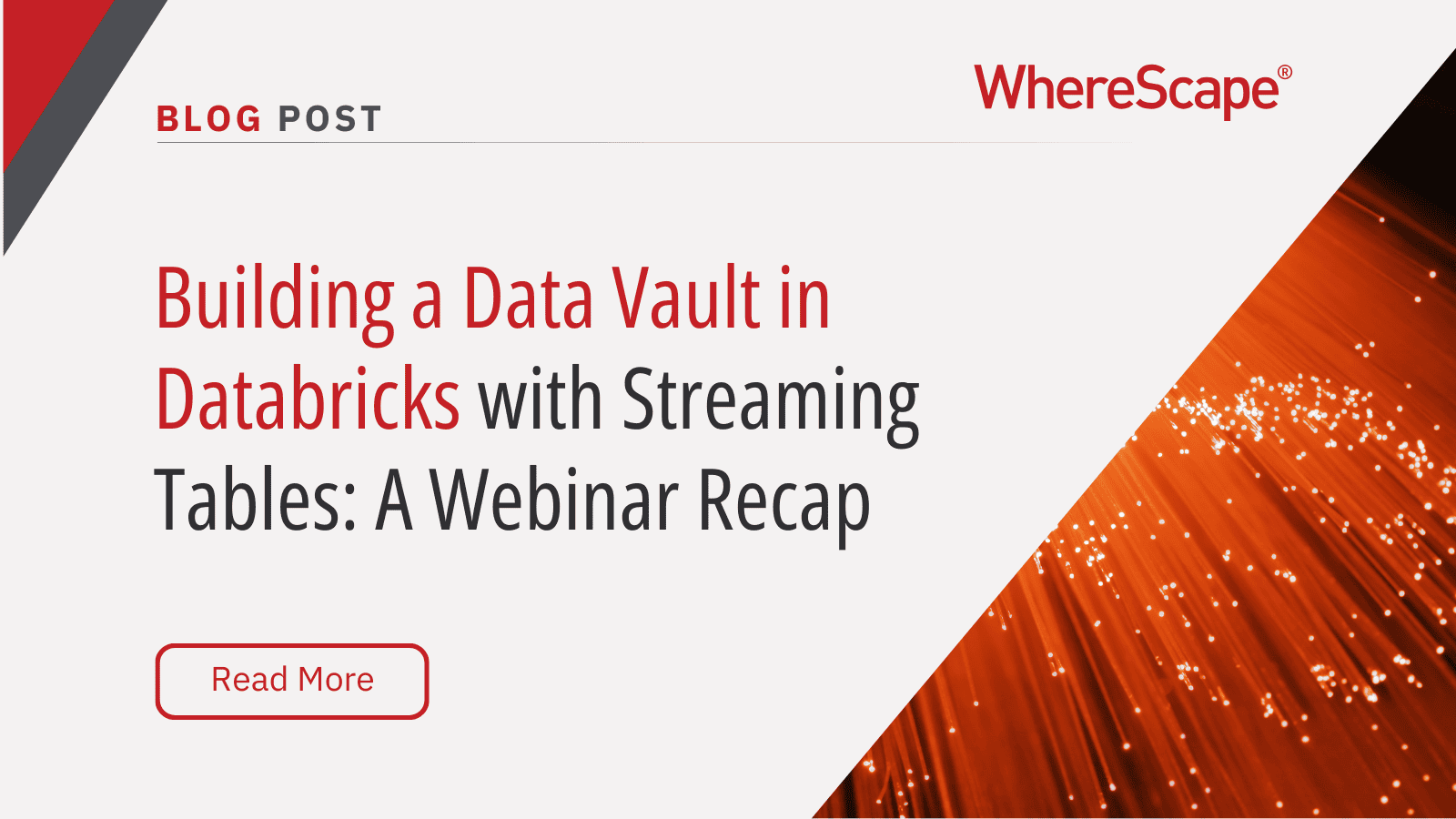Discover how-to unlock exciting new...
Webinar Recap: Data Vault & Databricks Integration with WhereScape
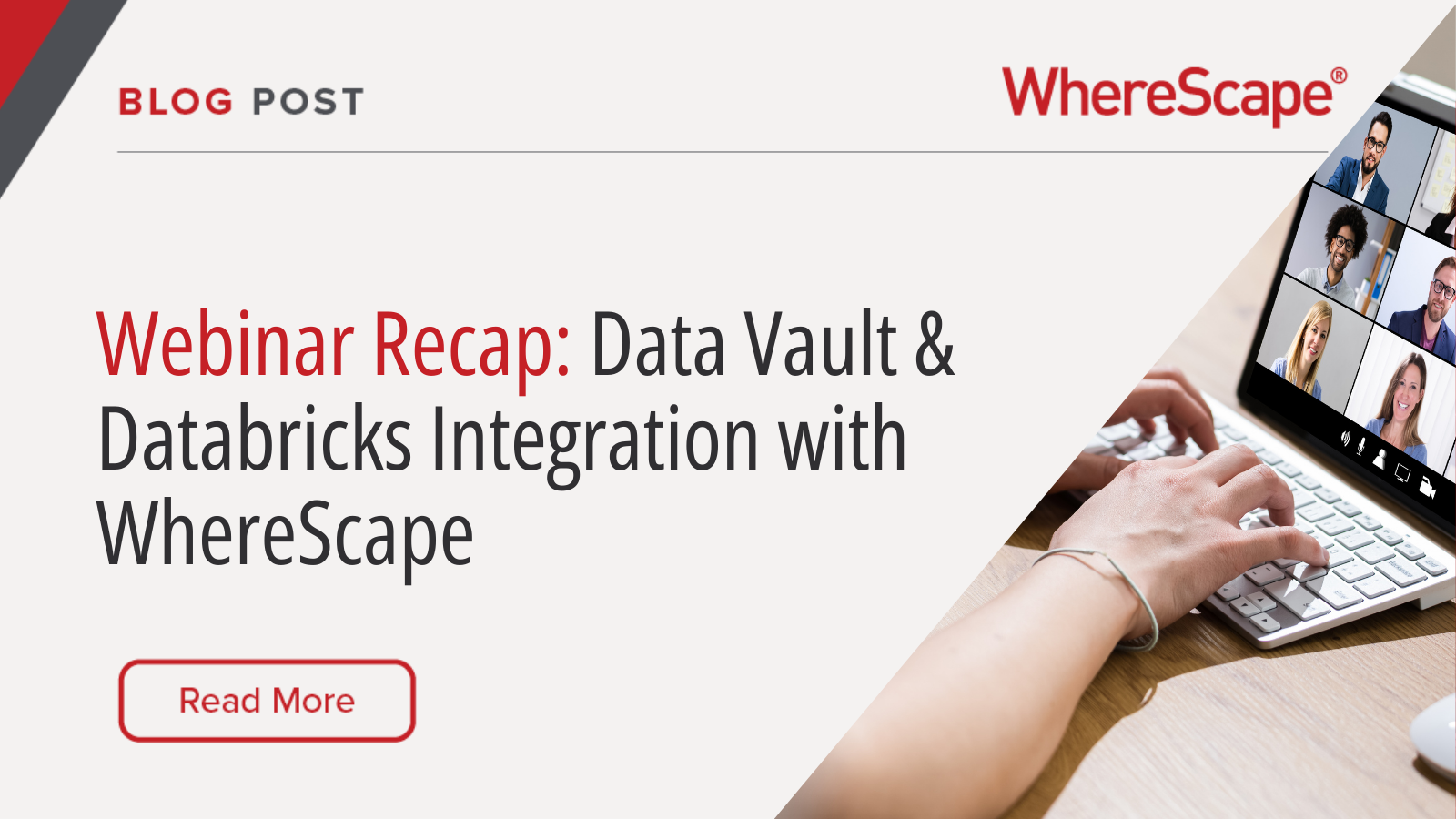
In our recent webinar, “Data Vault and Databricks: Automation Techniques, Best Practices, and Use Cases,” we had the pleasure of hearing from Kevin Marshbank, Principal Consultant at The Data Vault Shop. With over 20 years of experience, Kevin shared his insights on how combining Data Vault methodology with Databricks, facilitated by WhereScape’s automation tools, can significantly enhance your data warehouse automation strategy.
The Journey from Transactional Systems to Data Warehousing
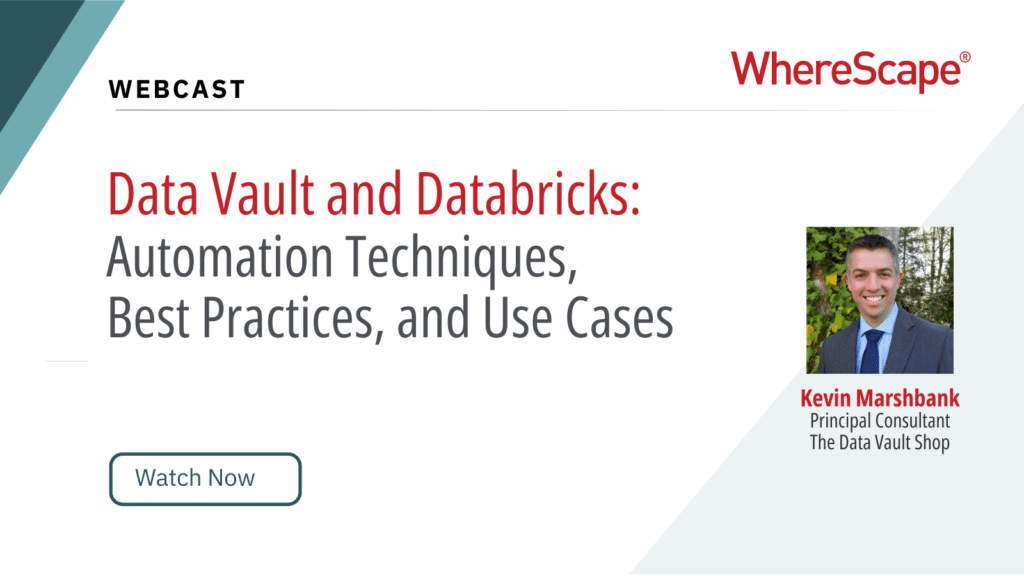
Kevin began by reflecting on his early career, where he started building high-volume transactional systems. He noted, “I actually got my start building high-volume transactional systems and migrated into data warehousing as I realized the value and need for it.” He shared how, initially, the focus was on making sure transactional systems were efficient and reliable. However, it soon became clear that while these systems enabled functionality, they did not provide the metrics and insights necessary for business leaders to make informed decisions.
“It really comes back to making sure that data is being tracked and being able to compile that data through data warehousing into metrics,” Kevin explained. This realization led him to explore data warehousing as a solution for transforming raw data into actionable insights. This journey eventually brought him to Data Vault 2.0, a methodology that not only emphasizes tracking and compiling data but also ensures that the data remains reliable and agile in response to changing business needs.
WhereScape Data Automation: Streamlining the Process
The webinar then delved into the core of the discussion—WhereScape’s data automation tools. Kevin provided an in-depth overview of WhereScape 3D and WhereScape RED, highlighting how these tools address the complexities often associated with traditional data warehousing methods. “WhereScape brings it all together—discovery, profiling, modeling, and building all those pipelines in an integrated fashion,” he said.
He elaborated on the pain points that many organizations face when trying to manually manage data warehousing tasks—such as the extended cycle time and the brittleness of processes that involve multiple handoffs between teams. “These processes are very brittle, and that cycle time is very extended,” Kevin pointed out, emphasizing the value of automation in reducing these inefficiencies.
Kevin shared a real-world example to illustrate the impact of WhereScape’s approach: “We had a process that took six months, and they weren’t done. We brought in WhereScape and did it within three days.” This example underscores the dramatic reduction in cycle time that WhereScape’s automation tools can achieve, as well as the increased collaboration and efficiency among development teams.
Integrating Data Vault 2.0 with Databricks
A significant portion of the webinar focused on the seamless integration of Data Vault and Data Vault 2.0 with Databricks through WhereScape’s automation tools. Kevin explained the Medallion architecture in Databricks, which organizes data into bronze, silver, and gold layers—each representing different stages of data refinement. He highlighted how this architecture aligns well with the principles of Data Vault 2.0, which emphasizes the importance of organizing data in a way that supports both historical tracking and agile business responses.
“Data Vault 2.0 and Databricks align very well in their approach to managing data,” Kevin noted. He detailed how the bronze layer corresponds to the raw data ingestion, the silver layer to the refined data in the raw vault, and the gold layer to the business-ready data that supports advanced analytics and AI/ML applications.
Kevin also discussed the importance of the Databricks Unity Catalog, a feature that centralizes metadata management, security, and data sharing. This tool plays a crucial role in ensuring that data governance is maintained across the organization, and WhereScape’s integration with Unity Catalog simplifies the management of these aspects in large-scale environments. “Unity Catalog really gives that overarching metastore across the catalog so that you can handle your security rules and your sharing,” Kevin explained, underscoring the importance of a unified approach to data management.
Real-World Applications and Best Practices
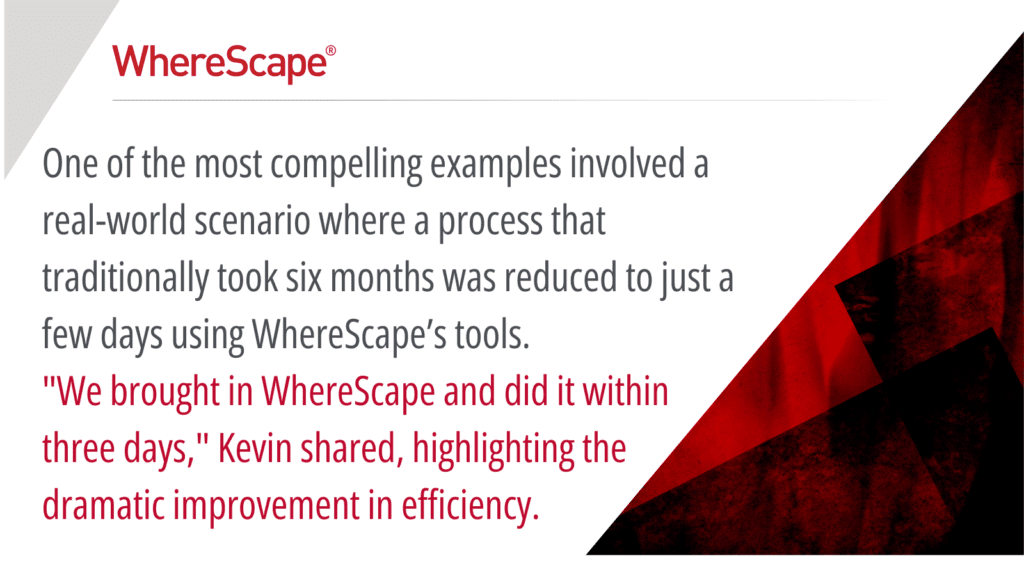
Throughout the webinar, Kevin provided practical examples of how combining WhereScape, Data Vault 2.0, and Databricks has led to significant improvements in data processing and analytics. One of the most compelling examples involved a real-world scenario where a process that traditionally took six months was reduced to just a few days using WhereScape’s tools. “We brought in WhereScape and did it within three days,” Kevin shared, highlighting the dramatic improvement in efficiency.
This example not only demonstrates the time-saving potential of WhereScape’s tools but also the ability to build trust with business stakeholders by delivering results quickly and accurately. “Instead of your business thinking you should be your thief by spending all this money with tons of consultants and engineers,” Kevin added, “it really does improve your business partnership, and that engagement with them.”
Kevin also discussed best practices around implementing Data Vault 2.0 on Databricks, emphasizing the importance of aligning people, processes, and technology. He explained how WhereScape’s tools help maintain this alignment by providing a consistent framework for building and managing data pipelines, which reduces the risk of errors and ensures that all team members are working from the same playbook.
Flexibility and Scalability with WhereScape
Another key takeaway from the session was the flexibility and scalability offered by WhereScape. Kevin pointed out that WhereScape is platform-independent, meaning it can support a wide range of data platforms, including Databricks. This capability is particularly useful for organizations looking to migrate from on-premises to cloud-based environments or to switch platforms altogether.
Kevin emphasized that WhereScape’s tools are designed to facilitate these transitions with minimal disruption. “We’ve had customers migrate from other platforms to Databricks, and it was an easy process,” Kevin said. “WhereScape allows for easy migration and adaptation to new platforms,” he explained, emphasizing the tool’s versatility and the efficiency of transitioning to new platforms without losing any of your existing work.
He also highlighted the importance of being able to adapt quickly to new technologies and platforms as they emerge. “One of the advantages of the tool is that support for new platforms comes on very quickly with WhereScape,” Kevin noted, illustrating how the tool is designed to keep pace with the rapidly evolving data landscape.
Q&A Session Highlights
At the end of the webinar, Kevin addressed several insightful questions from the audience. Here’s a summary of the key Q&A moments:
Q1: How customizable is the code generated by WhereScape, especially when working with Databricks?
A: Kevin explained that the code generated by WhereScape is fully customizable. “It’s an open book,” he said. “You can tweak the templates to meet your specific needs, whether it’s adding security statements or customizing processing logic.” He also highlighted that this flexibility is crucial for organizations that need to adapt their data processes to specific requirements or regulatory environments.
Q2: Does WhereScape support modern Databricks features like Delta Live Tables?
A: Yes, WhereScape supports Databricks Delta Live Tables. Kevin confirmed that WhereScape is equipped to handle Delta Live Tables, ensuring that organizations can leverage the latest Databricks functionalities within their data warehousing processes. “It’s already integrated into WhereScape’s automation tools,” he assured the audience, adding that this feature allows users to take full advantage of Databricks’ capabilities without additional manual setup.
Q3: What are some challenges when managing complex data models in Databricks, and how does WhereScape help?
A: Kevin acknowledged that managing complex data models can be challenging, especially in a dynamic environment like Databricks. However, WhereScape simplifies this process by automatically generating and deploying the necessary data structures, significantly reducing the manual effort required. “WhereScape takes care of producing and deploying those structures, so you don’t have to do it manually,” Kevin said. He emphasized that this automation not only saves time but also reduces the likelihood of errors that can occur with manual coding.
Q4: If we’re considering migrating to Databricks, how does WhereScape facilitate the process?
A: For organizations looking to migrate to Databricks, Kevin emphasized that WhereScape makes the process much smoother. “By cataloging and profiling your existing data warehouses, WhereScape can quickly generate the necessary models and pipelines for Databricks,” he explained. This reduces the time and complexity involved in migration, ensuring a faster and less disruptive transition. Kevin also pointed out that this capability allows organizations to take advantage of Databricks’ advanced features more quickly, enabling them to start reaping the benefits of the platform sooner.
Transforming Your Data Strategy with Data Vault and Databricks

This webinar provided a comprehensive look at how integrating Data Vault 2.0 with Databricks, powered by WhereScape’s automation tools, can transform your data warehousing strategy. The combination of these technologies enables organizations to build more agile, scalable, and high-performing data environments.
If you missed the live session, don’t worry! You can access the full recording here. If you have any further questions or want to explore how WhereScape can enhance your data warehousing projects, be sure to book a demo with us.
Thank you to everyone who joined us, and we look forward to seeing you at our next webinar!
ETL vs ELT: What are the Differences?
In working with hundreds of data teams through WhereScape’s automation platform, we’ve seen this debate evolve as businesses modernize their infrastructure. Each method, ETL vs ELT, offers a unique pathway for transferring raw data into a warehouse, where it can be...
Dimensional Modeling for Machine Learning
Kimball’s dimensional modeling continues to play a critical role in machine learning and data science outcomes, as outlined in the Kimball Group’s 10 Essential Rules of Dimensional Modeling, a framework still widely applied in modern data workflows. In a recent...
Automating Data Vault in Databricks | WhereScape Recap
Automating Data Vault in Databricks can reduce time-to-value by up to 70%—and that’s why we hosted a recent WhereScape webinar to show exactly how. At WhereScape, modern data teams shouldn't have to choose between agility and governance. That's why we hosted a live...
WhereScape Recap: Highlights From Big Data & AI World London 2025
Big Data & AI World London 2025 brought together thousands of data and AI professionals at ExCeL London—and WhereScape was right in the middle of the action. With automation taking center stage across the industry, it was no surprise that our booth and sessions...
Why WhereScape is the Leading Solution for Healthcare Data Automation
Optimizing Healthcare Data Management with Automation Healthcare organizations manage vast amounts of medical data across EHR systems, billing platforms, clinical research, and operational analytics. However, healthcare data integration remains a challenge due to...
WhereScape Q&A: Your Top Questions Answered on Data Vault and Databricks
During our latest WhereScape webinar, attendees had fantastic questions about Data Vault 2.0, Databricks, and metadata automation. We’ve compiled the best questions and answers to help you understand how WhereScape streamlines data modeling, automation, and...
What is Data Fabric? A Smarter Way for Data Management
As of 2023, the global data fabric market was valued at $2.29 billion and is projected to grow to $12.91 billion by 2032, reflecting the critical role and rapid adoption of data fabric solutions in modern data management. The integration of data fabric solutions...
Want Better AI Data Management? Data Automation is the Answer
Understanding the AI Landscape Imagine losing 6% of your annual revenue—simply due to poor data quality. A recent survey found that underperforming AI models, built using low-quality or inaccurate data, cost companies an average of $406 million annually. Artificial...
RED 10: The ‘Git Friendly’ Revolution for CI/CD in Data Warehousing
For years, WhereScape RED has been the engine that powers rapidly built and high performance data warehouses. And while RED 10 has quietly empowered organizations since its launch in 2023, our latest 10.4 release is a game changer. We have dubbed this landmark update...
The Assembly Line for Your Data: How Automation Transforms Data Projects
Imagine an old-fashioned assembly line. Workers pass components down the line, each adding their own piece. It’s repetitive, prone to errors, and can grind to a halt if one person falls behind. Now, picture the modern version—robots assembling products with speed,...
Related Content
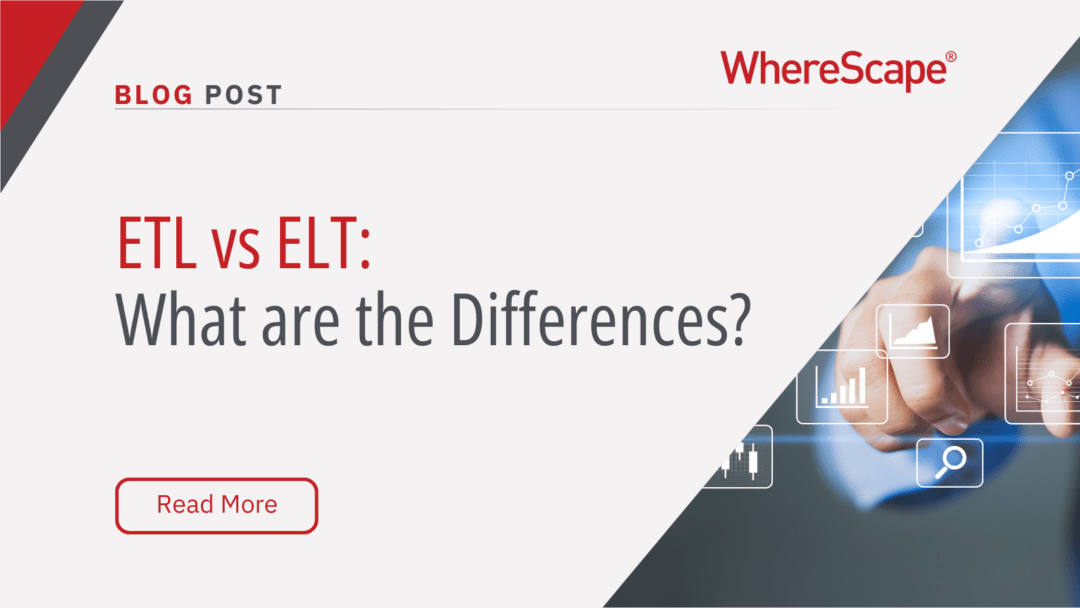
ETL vs ELT: What are the Differences?
In working with hundreds of data teams through WhereScape’s automation platform, we’ve seen this debate evolve as businesses modernize their infrastructure. Each method, ETL vs ELT, offers a unique pathway for transferring raw data into a warehouse, where it can be...
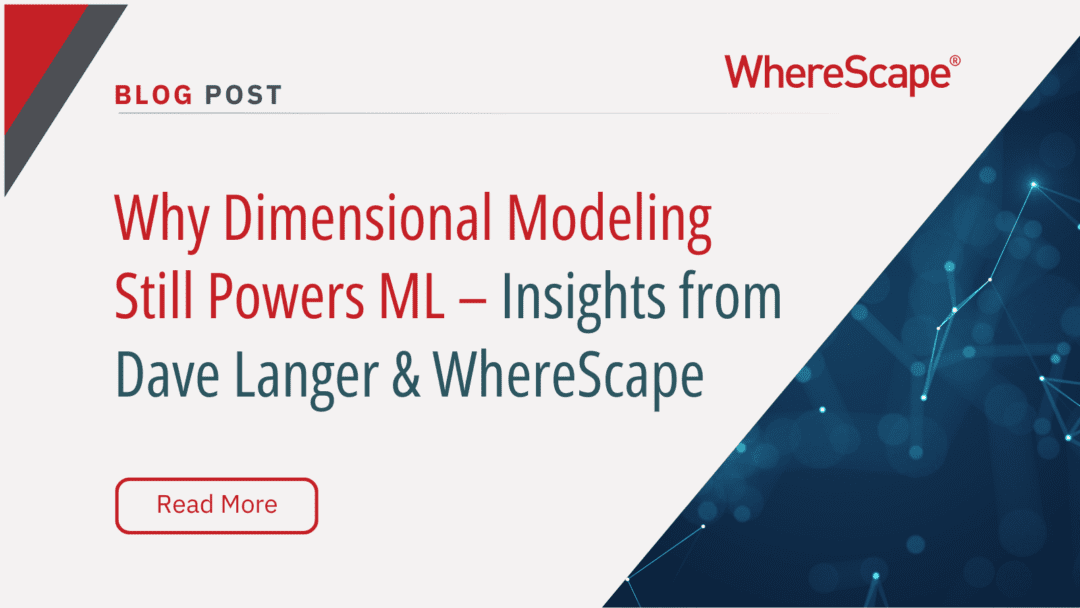
Dimensional Modeling for Machine Learning
Kimball’s dimensional modeling continues to play a critical role in machine learning and data science outcomes, as outlined in the Kimball Group’s 10 Essential Rules of Dimensional Modeling, a framework still widely applied in modern data workflows. In a recent...
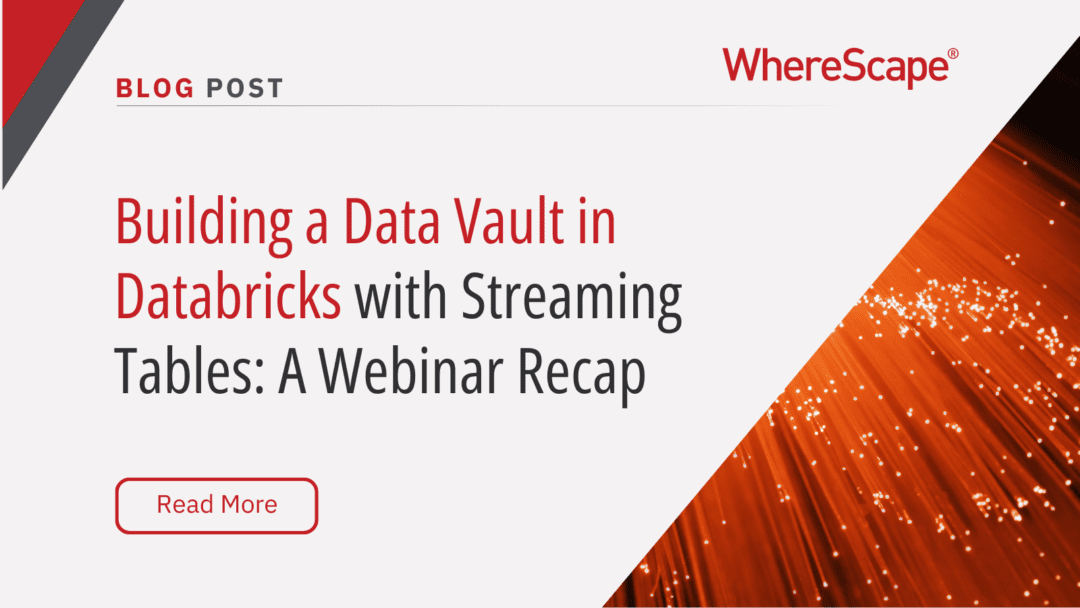
Automating Data Vault in Databricks | WhereScape Recap
Automating Data Vault in Databricks can reduce time-to-value by up to 70%—and that’s why we hosted a recent WhereScape webinar to show exactly how. At WhereScape, modern data teams shouldn't have to choose between agility and governance. That's why we hosted a live...
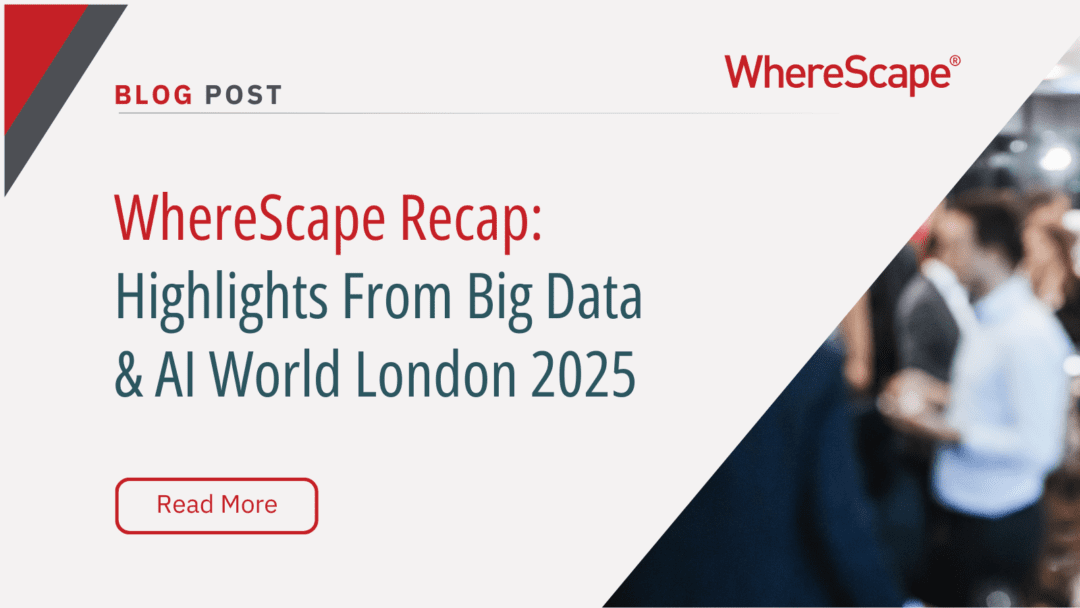
WhereScape Recap: Highlights From Big Data & AI World London 2025
Big Data & AI World London 2025 brought together thousands of data and AI professionals at ExCeL London—and WhereScape was right in the middle of the action. With automation taking center stage across the industry, it was no surprise that our booth and sessions...

